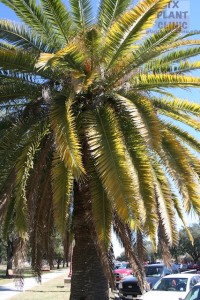 My colleague and collaborator, Dr. Greta Schuster at Texas A&M – Kingsville took me around the campus to show me some of the plants where samples were taken from for our detection assay for palm phytoplasmas. In South Texas, there has been a rash of palm trees dying. Usually when the palms start to decline, one of the symptoms are yellowing leaves. In fact, there are 2 related types of phytoplasmas that are well known to affect palms. One is called Lethal Yellowing – a common problem on coconuts in the tropics, and Date Palm Lethal Decline (also known as Texas Phoenix Palm Decline). In the past 2 years of studying the distribution of the problem, we have only detected the Date Palm Lethal Decline phytoplasma. In fact, through the efforts of Dr. Schuster’s group – we identified the Date Palm Lethal Decline phytoplasma on sabal palm (which would be considered a first find in Texas). We are in the process of sequencing the DNA for another form of confirmation to have the data publishable. We have yet to come across a Lethal Yellowing sample. The photo posted was taken a couple of days ago. This distinct yellowing of the foliage is troublesome, as it may point to Lethal Decline. However another part of this story is that this past week, much of Texas experienced multiple days of below freezing conditions. One response of this palm to cold is yellowing. So how do we tell the difference? One way would be to see if this damage had occurred BEFORE the freezing temperatures came along. If it had, then there is a good possibility that phytoplasmas may be involved in the decline. However, if these damage was only noticed after the cold event, then it is likely just a stress response to the cold. This also means that there is a good chance that the palm may recover if the damage is not too extensive. Another question that I frequently hear is: “Can cold temperatures really cause damage that quickly?” The answer to that is YES! It also depends on the the plants; some plants are more susceptible to the cold than other. For example, a tomato plant will have collapse within 24 hours after exposure to freezing conditions.
My colleague and collaborator, Dr. Greta Schuster at Texas A&M – Kingsville took me around the campus to show me some of the plants where samples were taken from for our detection assay for palm phytoplasmas. In South Texas, there has been a rash of palm trees dying. Usually when the palms start to decline, one of the symptoms are yellowing leaves. In fact, there are 2 related types of phytoplasmas that are well known to affect palms. One is called Lethal Yellowing – a common problem on coconuts in the tropics, and Date Palm Lethal Decline (also known as Texas Phoenix Palm Decline). In the past 2 years of studying the distribution of the problem, we have only detected the Date Palm Lethal Decline phytoplasma. In fact, through the efforts of Dr. Schuster’s group – we identified the Date Palm Lethal Decline phytoplasma on sabal palm (which would be considered a first find in Texas). We are in the process of sequencing the DNA for another form of confirmation to have the data publishable. We have yet to come across a Lethal Yellowing sample. The photo posted was taken a couple of days ago. This distinct yellowing of the foliage is troublesome, as it may point to Lethal Decline. However another part of this story is that this past week, much of Texas experienced multiple days of below freezing conditions. One response of this palm to cold is yellowing. So how do we tell the difference? One way would be to see if this damage had occurred BEFORE the freezing temperatures came along. If it had, then there is a good possibility that phytoplasmas may be involved in the decline. However, if these damage was only noticed after the cold event, then it is likely just a stress response to the cold. This also means that there is a good chance that the palm may recover if the damage is not too extensive. Another question that I frequently hear is: “Can cold temperatures really cause damage that quickly?” The answer to that is YES! It also depends on the the plants; some plants are more susceptible to the cold than other. For example, a tomato plant will have collapse within 24 hours after exposure to freezing conditions.
So we still have some cold weather conditions ahead of us before the constant heat comes back. When freezing conditions are predicted, protect your plants if possible. If it is a big susceptible plant than cannot be easily covered or moved, like a grown palm, some things that can still be done include wrapping the trunk with blankets and putting extra mulch on to insulate the root system. (Be sure to remove this from the trunk after the weather incidence is over).


